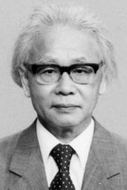Nationality Japan Fields Mathematics | Name Mikio Sato Role Mathematician | |
 | ||
Born April 18, 1928 (age 97) Tokyo, Japan ( 1928-04-18 ) Known for Bernstein–Sato polynomialsSato-Tate conjecture Awards Wolf Prize in Mathematics, Rolf Schock Prize in Mathematics | ||
Old time jazz by mikio sato
Mikio Sato (佐藤 幹夫, Satō Mikio, born April 18, 1928) is a Japanese mathematician, who started the field of algebraic analysis. He studied at the University of Tokyo and then did graduate study in physics as a student of Shin'ichiro Tomonaga. Since 1970, Sato has been professor at the Research Institute for Mathematical Sciences, of Kyoto University.
Contents
- Old time jazz by mikio sato
- Doraemon by kurosu katsuhiko arr by mikio sato between dream come true joyeux winds
- References

He is known for his innovative work in a number of fields, such as prehomogeneous vector spaces and Bernstein–Sato polynomials; and particularly for his hyperfunction theory. This theory initially appeared as an extension of the ideas of distribution theory; it was soon connected to the local cohomology theory of Grothendieck, for which it was an independent origin and to expression in terms of sheaf theory. Further, it led to the theory of microfunctions, interest in microlocal aspects(Microlocal analysis) of linear partial differential equations and Fourier theory such as wave fronts, and ultimately to the current developments in D-module theory. Part of Mikio Sato's hyperfunction theory is the modern theory of holonomic systems: Partial Differential Equations (PDEs) over-determined to the point of having finite-dimensional spaces of solutions(Algebraic analysis).
He also contributed basic work to non-linear soliton theory, with the use of Grassmannians of infinite dimension. In number theory, he is known for the Sato–Tate conjecture on L-functions.
He has been a member of the National Academy of Sciences since 1993. He also received the Schock Prize in 1997 and the Wolf Prize in 2003.
His disciples include Masaki Kashiwara, Takahiro Kawai, Tetsuji Miwa, Michio Jimbo, etc. There were things sometimes called "Sato School" .
